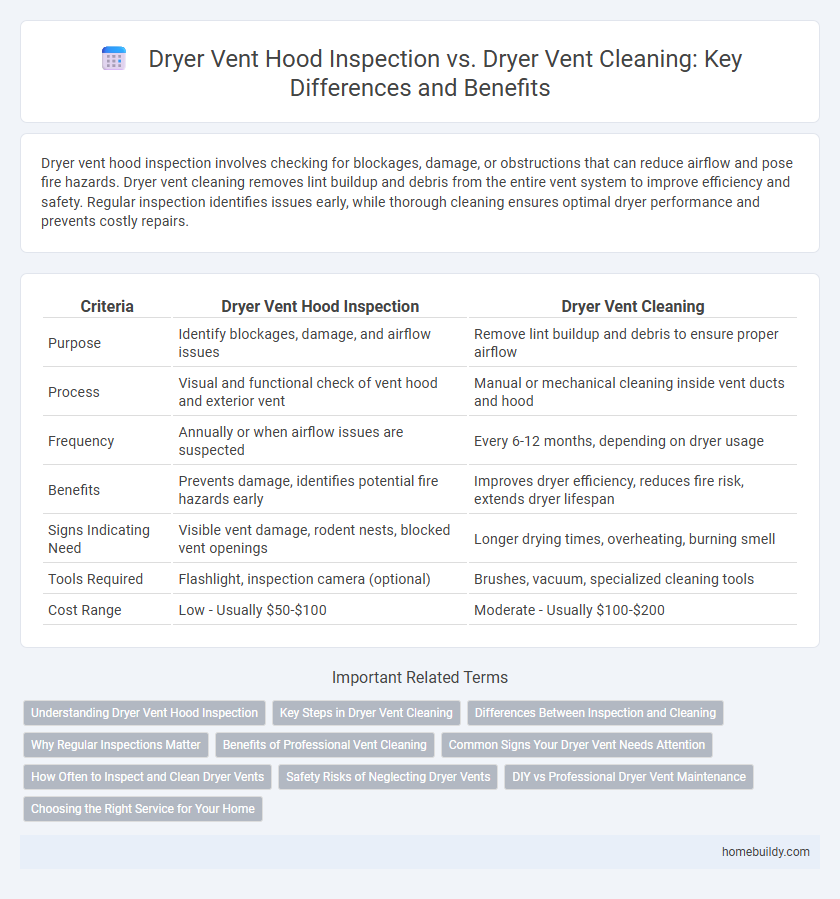Dryer vent hood inspection involves checking for blockages, damage, or obstructions that can reduce airflow and pose fire hazards. Dryer vent cleaning removes lint buildup and debris from the entire vent system to improve efficiency and safety. Regular inspection identifies issues early, while thorough cleaning ensures optimal dryer performance and prevents costly repairs.
Table of Comparison
| Criteria | Dryer Vent Hood Inspection | Dryer Vent Cleaning |
|---|---|---|
| Purpose | Identify blockages, damage, and airflow issues | Remove lint buildup and debris to ensure proper airflow |
| Process | Visual and functional check of vent hood and exterior vent | Manual or mechanical cleaning inside vent ducts and hood |
| Frequency | Annually or when airflow issues are suspected | Every 6-12 months, depending on dryer usage |
| Benefits | Prevents damage, identifies potential fire hazards early | Improves dryer efficiency, reduces fire risk, extends dryer lifespan |
| Signs Indicating Need | Visible vent damage, rodent nests, blocked vent openings | Longer drying times, overheating, burning smell |
| Tools Required | Flashlight, inspection camera (optional) | Brushes, vacuum, specialized cleaning tools |
| Cost Range | Low - Usually $50-$100 | Moderate - Usually $100-$200 |
Understanding Dryer Vent Hood Inspection
Dryer vent hood inspection involves a thorough examination of the exterior vent cover, checking for blockages, damage, and proper flap operation to ensure efficient airflow and prevent moisture buildup. This process identifies signs of lint accumulation, cracks, or pest infestations that could compromise dryer performance and safety. Regular inspections help maintain optimal dryer function and reduce fire hazards without the more intensive effort of a full dryer vent cleaning.
Key Steps in Dryer Vent Cleaning
Dryer vent cleaning involves thorough removal of lint and debris from the vent system using specialized brushes and vacuum tools to ensure proper airflow and reduce fire risk. Key steps include disconnecting the dryer, inspecting the entire vent line, and meticulously cleaning both the interior vent duct and exterior vent hood to eliminate blockages. Regular inspection focuses on assessing vent condition and airflow, while cleaning provides the essential maintenance to optimize dryer efficiency and safety.
Differences Between Inspection and Cleaning
Dryer vent hood inspection involves assessing the vent system for damage, blockages, and proper installation to ensure safe and efficient operation. Dryer vent cleaning focuses on removing lint, debris, and buildup that restrict airflow and pose fire hazards. While inspection identifies potential issues, cleaning actively resolves airflow obstructions to maintain dryer performance and safety.
Why Regular Inspections Matter
Regular inspections of dryer vent hoods prevent lint buildup that can lead to reduced airflow, increasing the risk of fire hazards and energy inefficiency. Inspecting the vent hood ensures proper sealing and damage detection, avoiding moisture intrusion that can cause mold growth and structural damage. Consistent inspections extend the lifespan of both the dryer vent hood and the appliance by maintaining optimal performance and safety standards.
Benefits of Professional Vent Cleaning
Professional dryer vent cleaning ensures the removal of lint buildup and debris that can cause blockages, enhancing dryer efficiency and reducing fire hazards. Regular inspections paired with thorough cleaning improve air circulation and extend the lifespan of both the vent system and the dryer. Expert cleaning also prevents moisture buildup, minimizing mold growth and maintaining indoor air quality.
Common Signs Your Dryer Vent Needs Attention
Common signs your dryer vent needs attention include longer drying times, excessive heat around the dryer, and a burning smell during operation. A dryer vent hood inspection identifies blockages, damaged vent covers, and improper vent placement that can restrict airflow. Dryer vent cleaning removes lint buildup and debris to restore proper ventilation and prevent fire hazards.
How Often to Inspect and Clean Dryer Vents
Dryer vent hoods should be inspected at least once a year to ensure there are no blockages, damage, or animal nests that can impede airflow and pose fire hazards. Dryer vent cleaning is recommended every 6 to 12 months, depending on usage frequency and the length of the vent duct, to remove lint buildup and improve dryer efficiency. Regular inspection combined with timely cleaning extends the lifespan of the dryer vent system and maintains safe drying performance.
Safety Risks of Neglecting Dryer Vents
Neglecting dryer vent hood inspection increases the risk of lint buildup, which can cause dryer fires and reduce appliance efficiency. Regular dryer vent cleaning removes blockages that restrict airflow, preventing carbon monoxide buildup and overheating hazards. Prioritizing both inspection and cleaning ensures safe operation and extends the lifespan of the dryer system.
DIY vs Professional Dryer Vent Maintenance
Regular dryer vent hood inspection helps identify clogs and damage early, preventing fire hazards and improving dryer efficiency. DIY vent cleaning may be suitable for minor lint removal, but professional dryer vent maintenance ensures thorough debris extraction, duct repair, and compliance with safety standards. Scheduling annual professional inspections maximizes dryer performance and extends appliance lifespan by addressing hidden blockages and vent hood integrity.
Choosing the Right Service for Your Home
Dryer vent hood inspection assesses the condition and functionality of the vent cover, identifying issues like blockages, wear, or damage that can affect airflow and safety. Dryer vent cleaning removes lint buildup and debris from the entire vent system to improve dryer efficiency and reduce fire risks. Choosing the right service depends on whether your goal is to detect potential problems early or to ensure optimal airflow by eliminating obstructions in your dryer vent system.
Dryer vent hood inspection vs dryer vent cleaning Infographic

 homebuildy.com
homebuildy.com